Case Study: In-Stream and Out-Stream Video for Mongrel Media







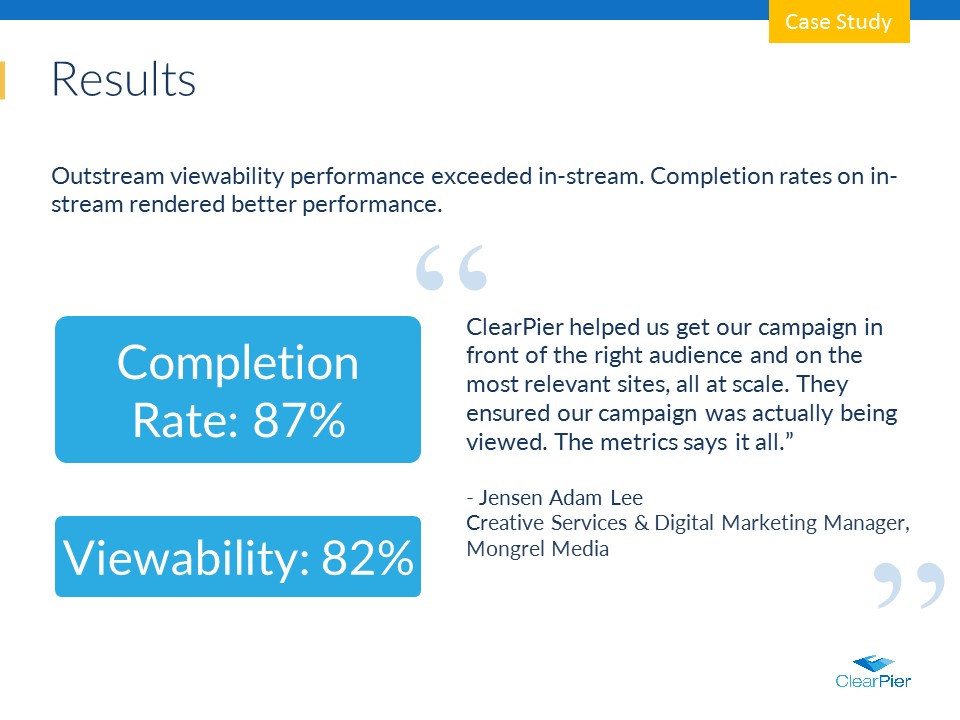
Want to learn more? Connect with our team at sales@clearpier.com
The Experts Weigh in On Programmatic and Performance in the Year Ahead
It comes as no surprise, that more brands are turning to Performance Marketing, and to vendors who can provide the technology to facilitate Performance.
Performance Marketing is on the up and up, year after year. In a recent article on MarTech Today, columnist Jim Yu discussed Performance as an imperative for CMOs worldwide.
At the heart of his discussion, he urges that performance-led platforms should be at the core of the marketing stack. As Yu puts it, “The CMO’s performance imperative demands that they can clearly demonstrate how every element of their spend is bringing about meaningful returns, lest they fall prey to the very real risk of budget-slashing.”
Performance is the overarching concern for marketers everywhere, to justify maintenance and growth of their budgets.
So it comes as no surprise, that more brands are turning to Performance Marketing, and to vendors who can provide the technology to facilitate Performance but not sacrifice scale. But where will Performance lead marketers?
We sat down with ClearPier’s Ad Ops and Client Services team to get a better understanding of the future of Performance Marketing in the year to come. Here’s what ClearPier’s Demand Optimization Manager, Terry Kalambalikis, and Digital Analyst, Albert Ng, had to say about performance marketing.


1. What can we expect for Performance Marketing in the year ahead?
Albert Ng, Digital Analyst:
I believe Programmatic buying will be the base of all digital performance marketing in the future. It’s the only way to move forward with accountable marketing.
The automation of programmatic buying will evolve and be extended towards optimization and contextual/behavioural learnings, in which as a result provide insight and recommendations to accelerate the process of taking the appropriate actions for a better performance
CTR will no longer be true measurement for performance. Instead, it would be primarily be measured through attribution.
Brands and Marketers will begin to realize that attributions requires them start applying processes to verify the data they are running on. Along with quality inventory, marketers will make the attributions part of a broader plan in order to create a solid foundation of data to run the most effective marketing campaigns.
2. What marketing trend or buzzword are you totally over?
Albert Ng, Digital Analyst:
“Engagement.” Honestly, this is probably THE most overused word amongst marketers. It is not an actual measurement of performance, it is a fluff word used to generalize any results of performance. It’s also not specific enough and so doesn’t provide enough insight. Scroll depth, for example, is a strong measurement because it indicates how deeply engaged your visitors are with your content.
Engagement alone will include accidental clicks which can skew your results. Engagement over time, on the other hand, is a more specific metric that actually tells you something: your visitor’s propensity to return after their first visit. Engagement, isn’t enough, you need to expand the metric to get real insights.
Terry Kalambalikis, Demand Optimization Manager:
“Millennial” – What is a Millennial? How do you really define an entire generation with varying interests, hobbies and issues? What really makes them different than anyone else aside from the year they were born?
I mean, you get 29 year olds who may like Hockey, Politics, Movies, Videogames etc., but you also get 50 year olds who can and do like the exact same things just as you get 17 year olds who may be interested in the exact same things. They consume the same content as anyone else, and aren’t the only ones using smartphones or social media.
So how does one market to Millennials? I think this word is over used by pretty much everyone and is just a lazy way to define a group that doesn’t really exist.
3. What do you think the biggest challenge advertisers and brands will now face?
Albert Ng, Digital Analyst:
With so much content being created daily digitally, it becomes difficult to be able to authenticate or verify any third party sources that are being run by the advertisers. Brand safety is going to be the top concern, globally which means only vendors who can guarantee it – or at least has brand safety as a top priority – will win.
Terry Kalambalikis, Demand Optimization Manager:
Not necessarily a new challenge, but I would say Ad Fraud.
There’s no fool-proof way to combat fraud, and no third party actually provides a solution that prevents it. You can monitor it, and possibly action on it once you identify the problem, and use various wrappers that may look out for suspicious traffic and monitor for bots, but in the end, it won’t stop the fraud from happening, and would require media buyers and marketers to actively monitor reports and react on the fly, which is not only a massive, time consuming task, but a task that is likely almost impossible.
Those that enable fraud always find new ways to get ahead of marketers and exploit the system, just the same as how those who create malware and viruses are almost always ahead anti-virus programs, so the fight against ad fraud will be something that will continue to be a problem through 2017, and likely grow into a larger problem as more and more spend is pushed into the digital ad space.
Want to learn more? Connect with our team at sales@clearpier.com
[Video] The Ten Biggest Marketing Trends of 2017
If you’re wondering what the big trends to look out for are, just watch this.
Want to learn more? Connect with our team at sales@clearpier.com
9 Reasons Why Attracting New Customers is Just Like Dating
Converting high value traffic into customers is an art; the art of courtship.
This week I bet a lot of you are gearing up to woo someone special for Valentine’s Day.
But it’s a challenge, isn’t it? How do you get your desired to notice you, to be willing to give their attention to you, to be interested in you, and to spare their valuable time for you?
For those of us in the business of demand generation and lead nurturing, these questions about dating actually sound a lot like what we ask about our prospective clients.
Attracting new customers is a lot like dating, it’s an art form but it also requires a scientific approach for proper execution. A worthwhile date, after all, strikes a balance between mystery and good planning, leaving your S.O. wanting more.
So what can we learn about attracting new customers from the art of dating?
1. Figure Out What You Want
We all have an ideal guy or girl in mind. Do they have a beautiful golden mane that glistens in the sun? Are they beautifully sculpted like a god? Do they love long walks on the beach and writing wistful poetry that they whisper into your ear at night?

In the dating world, we usually have a general idea of what our ‘type’ is. It should be the same for your marketing.
Get a better understanding of exactly who your ideal customer is by doing some diligent research and asking the right questions. Learn more from your current customer base by sending out surveys. If you’re a B2B, you might ask:
- What’s their role at work?
- What is their day-to-day like?
- What are the biggest work-related challenges they face?
- What’s their educational background?
- What peeves them about vendor products and services?
If you’re a B2C, you might ask:
- What’s their role home?
- Who does the majority of the household purchases?
- What is their day-to-day like?
- What’s the biggest challenge to their day?
- What’s the most important thing a product or service should do for them?
You can interview your customers through email surveys, or by taking your clients out to lunch to get their feedback. If you enable quick surveys to take place just after your signup process, you can immediately retrieve more information from your customers when they are most willing to provide it – when they sign up.
2. Get to Know Your Date
Once you’ve gathered enough information about your current customer’s needs and wants, pause to consider how your business or services fit for them. Then create Buyer Personas for your ideal prospective clients. HubSpot in fact has some great Buyer Persona templates you can use.
Use your imagination. If you can imagine that your ideal guy can wield Mjolnir like its NBD (which means carrying you over the threshold should be a piece of cake), then you can imagine some kick-ass Buyer Personas. Just think of your Buyer Personas, as your ultimate Playbook.

What’s their demographic? What titles do they hold? What’s their backstory? Give them one. What positive things would they say about your product, what are the negatives? What do they really care about? Flesh out your ideal clients and get to know their buyer persona, truly understand what their needs are and what drives them to buy.
The more you know what you want – or rather who you want- to be your customers, that is, the easier it is to woo them.
3. Pursue a Relationship, not a One-Night-Stand
This is usually a pretty daunting task in the dating world. Props to all of you who manage to muster up the courage to walk up to someone at the bar and say “Hey you, want to be friends?” Of course, depending on your line the outcome isn’t always positive.
So how do you get in front of the right audiences during this awkward phase when they don’t know you, they might not even want to get to know you, but you really want to get to know them?
By building a relationship and like all strong relationships, that requires trust. How do you achieve this?
Boost your Content Marketing Strategy. Lead the conversation that should be taking place between you and your audience. Provide prospects with valuable, educational, and actionable content that’s useful. But don’t be pedantic and stay relevant. There’s nothing worse than having a date mansplain, or talk about things that you have absolutely no interest in.
Wait, there is something worse – a date who talks incessantly about nothing but their self. You’ve been on some of those dates, terrible right?
Exactly. Make sure your content marketing strikes a balance between valuable industry relevant content, and promotional “hard sell” content. Ensure your audience understands what your business stands for, your mission and how you benefit them, but don’t just talk about you. The majority of your content should actually consist of high value entertaining or educational material that audiences would enjoy.
4. Be Honest, Be Steadfast, Be a Gentleman
Those are the dating terms. Let’s translate them into marketing terms: be transparent, be consistent, and provide quality service.
This applies across every marketing channel. If you want to build a repertoire with your audience (read: date), then you must be honest. You can’t misrepresent your services and features, and you can’t over promise but under deliver. The second they discover you’re a fraud, say goodbye to dates 2 and 3 and everything else that comes with the third date.
You give your audiences the truth. Negative reviews show up on Yelp? You take that like a champ and you don’t delete those comments. Instead, you show your dedication to audience by acknowledging that feedback and strive to improve your service.
Consistency is also key across every marketing channel. On social media, you got to keep up a consistent conversation. For your content strategy, posting consistently will keep your audiences coming back for more. If you’re running paid ads on websites, make sure you consistently appear on the sites where your audience actually visits.
Consistency keeps you top of mind. It ensures you continue to pay attention to your audience. When you share an article on your blog for your audience, you’re saying “Hey, I was thinking of you and I thought you might like this.” When you “like” what they Tweeted, you’re saying “That’s a great point. I am listening to you.”
And together, that adds up to being attentive to you date, or rather your prospective customers, which is really just good customer service.
5. Don’t Look for Love in the Wrong Places
So you want a relationship. You want to settle down and maybe start a little fam. But for some reason, you are still looking for dates at 3 AM in the club. Come on! You know better than that.
Attracting new customers that you want to have as clients for life, is the same. Get in front of your audience at the right place and the right time and you need to keep your ads relevant. How?
When running programmatic campaigns, you have to ensure your targeting parameters are on point. You’re not going to run your ads for, let’s say Hummers, on a publisher that advocates green energy and environmental friendly lifestyles because you know that the audience reading that publisher is not going to be interested in your ad. That’s a waste of ad dollars.

To target your audiences better, choose to work with a vendor who can help you leverage data from a Data Management Platform (DMP), allowing you to layer audience behavioral and contextual data over your targeting. Better yet, get your hands on some first-party audience data (*ahem* ClearPier offers first-party publisher audience data) so you can segment your audience list and really target your ads.
6. Treat Your Dates as Individuals
You’re dating Sarah. Sarah like to go to the ice cream parlor for milkshakes which she dips into her french fries – she’s quirky like that. You met Sarah at concert. But you’re also seeing Sally who you met at a friend’s party. Sally is lactose intolerant, but she still likes dessert. When you ask Sarah out, you’re going to suggest going to that new hipster ice cream parlor on Queen and Spadina. She’s going to love it, she says yes. So you decide to try the same thing out with Sally. You suggest going to that new hipster ice cream parlor on Queen and Spadina. She, obviously, says no and is a bit turned off by you now.
What went wrong?
You didn’t tailor your messaging!
It’s important to treat each of your customers as individuals and to segment your audience list so that when you communicate with your customers, you’re sending a targeted, relevant, and personalized message. Tailored messages are the only ones your audience will respond to, and it’s the same when it comes to Sally. Here are some creative ways you can segment your audience list.
7. Prove that You’re Actually Worth It
So you’ve been on a few dates now, that is, you have a few customers now. You’ve been keeping up your communication, staying attentive and delighting your customers with brilliant high-value content. Great.
The challenge here is to turn your customers into brand advocates so that you can then ask for feedback and testimonials to continue proving your value. But how?
Actions speak louder than words. First, deliver on the marketing promises that you about your product or services. Remember, provide attentive and quality customer experiences. And finally, appreciate your customers and show them you care.
Before you know it, they’ll be telling the whole world just how great you are.
8. If You Love Them, Let Them Go – But then, Retarget
It’s bound to happen. Your date might just not be that into you right at this moment. That’s okay, let them go. But then, you just got to get back in front of them and remind them of how great you are and they should get back together with you, stat.
Okay, this last analogy might be pushing it a bit. This is one of those few times where dating and marketing aren’t exactly the same. In the real world, applying “retargeting” strategy might be a little creepy.
In the digital marketing world, not so much! The reality is that the customer journey is not linear and often times there’s a long period of research that might take place before conversion actually happens. As marketers, we must be patient. But we can push prospective clients along towards conversion faster with pixel-based retargeting.
But keep this in mind when you’re retargeting:
- Your frequency cap: no one likes to see the same retargeted add too often, following them around the internet wherever they go. Forget that. Put a cap on it. Retargeter recommends no more than 17-20 retargeted ads for your visitor per month.
- Refresh your ads: seeing the same creative every where is terrible. It might even make people clear their cookies – not what we want. In fact, click-through rates can drop by 50% after 5 months of running the same creative. Stop creative fatigue, switch up your ads!
- Segment your audience by stage in the purchasing funnel: the further along they are, the more likely they are to convert (e.g. if they’ve looked at your pricing page). If your visitor has only viewed your home page, they may still be looking for more information. By segmenting your audiences, you can retarget with the right ad to inspire the next action and push your prospects further down the conversion funnel.
9. When They Fall in Love, They’re Your Biggest Fan
Finally, just like in the dating world when your date actually falls in love with you, they become your biggest cheerleader.
The same can be said about prospects who turn into customers. But remember, it’s a relationship and it requires nurture and hard work. For marketers, this means continuing to provide the best customer service possible while listening to your audiences. Keep it up, and they’ll be a fan for life.
Want to learn more? Connect with our team at sales@clearpier.com
[Video] Valentine's Day Marketing Stats That Will Make You Rethink Your Marketing
The way consumers celebrate Valentine’s Day has changed.
This video explains how.
https://youtu.be/ZCAbMT_RtfI
Did you know that Valentine’s Day sales reached an all-time high in 2016 at $19.7 Billion, according to the National Retail Federation.
Fortune and MarketWatch report that this year, sales for the holiday are projected to dip down to $18.2 Billion.
But nonetheless, Valentine’s Day continues to be one of the year’s most popular holidays – at least when it comes to consumer spending.
Marketers take note, the way consumers are celebrating Valentine’s Day has changed and the stats might actually surprise you.
1. 54.8% of Americans Celebrate Valentine’s Day
In fact, people of all ages celebrate Saint Valentine’s Day.
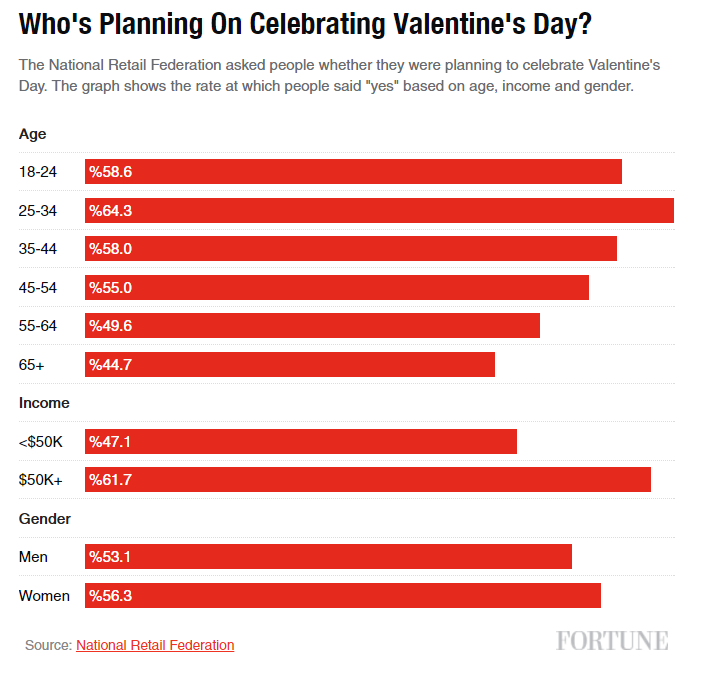
2. Valentine’s Day Consumer Spending is Second Only to Christmas
Spending lots of money on Valentine’s Day is pretty normal. On average, people spend $512.03 for the special day.

Considering what people are buying, the numbers add up…
3. Jewelry is the biggest consumer spending category, followed by Experiences
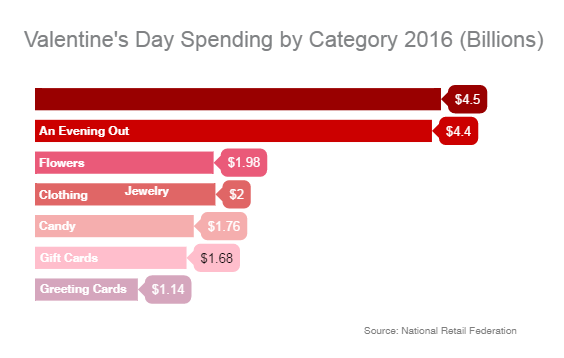
4. $681 Million total Valentine’s Day gifts are spent on pets

Just a few of our very own doggy friends at ClearPier.
That’s right. Consumers love their pets and Valentine’s Day is just another excuse to dote on our furry friends. In fact, 19% of all Valentine’s Day gifts go to pets, averaging out at $26 per shopper.
5. Singles, couples, men and women all participate – but men on average spend TWICE as much
No a days, it would be a mistake for marketers to focus on only couples. Many single people now also celebrate Valentine’s Day, while others simply buy presents for friends.
In fact, Bing has reported that when people search “Valentine’s Day Gifts For…” 22% of people fill the rest of that sentence in with “husband,” 20% finish it with “friend,” and 17% type in “boyfriend.”
And although things have changed, some traditional gender norms seem to persist as men typically spend on average twice as much as women for Valentine’s Day. A single man may spend on average $71 for the holiday, while a single woman may only spend $40, although people in a relationship typically spend more.
6. More people are shopping online, and Mobile drives that growth
From 2015 to 2016, mobile searches for Valentine’s Day rose from 40% to 48% according to Bing. However, there is still a 50-50 split between desktop and mobile shoppers.
7. 50% of proposals actually happen around Valentine’s Day which contributes to keep jewelry a popular gift item
That’s good news for brands advertising big ticket items like engagement rings, ear rings, necklaces, and more.

8. But Experiences based gifts or evenings out are also popular – great news for local search.
39% of individuals prefer gifts like tickets to a concert, a dinner out, or a day at the spa or a relaxing stay at a ritzy hotel to material gifts.
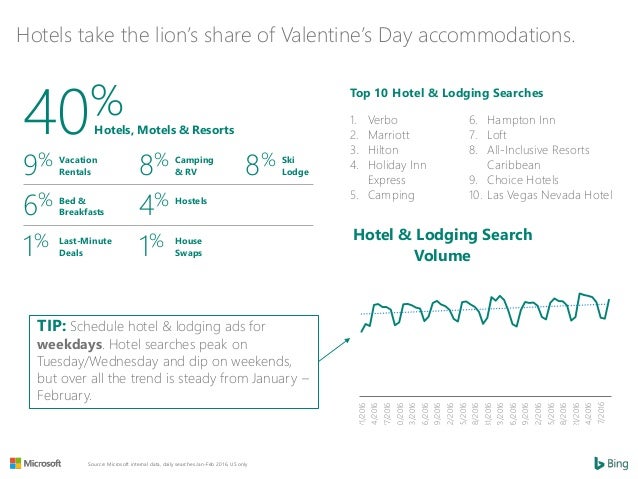
And with 34% of consumers planning to eat out on Valentine’s Day, restaurant ads actually peak the day before the holiday. And the reason for that may simply be that Valentine’s Day gifting usually includes less planning and more impulse purchases instead.
9. These were the most popular search terms in 2016 on Bing for Valentine’s Day (Desktop):
- Etsy
- Flowers
- Olive Garden
- Valentine’s Day
- Victoria Secret
- Edible Arrangements
- Love
- Kay Jewelers
- Hearts
- Eddie Bauer
10. These were the most popular search terms in 2016 on Bing for Valentine’s Day (Mobile):
- Jewelry
- Valentine’s Day
- Engagement rings
- Earrings
- Love
- Gift card
- Pandora charms
- Etsy
- Necklace
- Online grocery
11. Valentine’s Day results in 7.6% increase of usage for matchmaking apps like Tinder
In fact, according to Tinder, last Valentine’s Day the app saw a 7.6% usage increase and a 6% match increase (U.S.). Messaging also increases by 5.2% (U.S.) on Tinder around Valentine’s Day.

So it’s a happy Valentine’s Day for many, indeed.
You can get more Valentine’s Day marketing insights from Bing in their Search Bing for Love presentation.
Want to learn more? Connect with our team at sales@clearpier.com
ClearPier's Solavid Division Heads to Barcelona for MWC 2017
Mobile World Congress is happening February 27-March 2 this year in Barcelona! We’re happy to announce that ClearPier’s Solavid Division will be attending.
The mobile industry continues to be characterised by high levels of growth and opportunity, and as the industry becomes more dynamic, the opportunities within it increase in equal amount, as do the challenges. In 2017, the Mobile World Congress conference programme will provide an essential, in-depth coverage of the contemporary and future mobile industry, highlighting specific areas of growth and opportunity.
ClearPier’s Jignesh Shah, CTO, Theo Terris, CEO of Solavid by ClearPier, and Amir Keren, Head of Video at Solavid, by ClearPier will all be in attendance.
If you’re an advertiser or publisher and will be at Mobile World Congress and want to learn more about ClearPier’s video solution, schedule a meeting with us now!
Email video@clearpier.com.
We hope to see you there!
How to Choose the Right Marketing Attribution Model
Your Quick Guide to 8 Different Attribution Models
You’ve planned the best campaign you can. You’re going to do a great job executing. But how do you plan on measuring your success?
You’ve got to make sure you’ve chosen the right attribution model, of course. What’s attribution modeling? An attribution model is a set of rules that defines how you credit each conversion or sale at specific consumer touchpoints along the sales funnel.
How do you choose the right marketing attribution model that’s right for you?
Below you’ll find a quick guide to 8 different acquisition attribution models. Keep on reading and discover which attribution model is right for your campaigns.
1. Last Interaction or Last Click Model
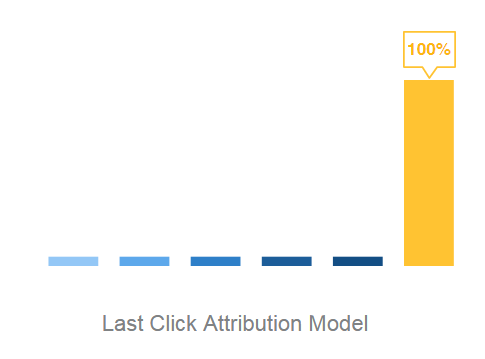
The Last Interaction or Last Click Attribution model is a standard in most web analytics. In this model, all credit is assigned to the last event – whether is a click or any other type of interaction a customer had – just before conversion.
Historically, almost all conversions were attributed to the last click and Direct channel (traffic comprised mainly of visitors proactively seeking you out by entering your URL manually). The Last Click model is simple, and for that reason highly appealing. Its easy to track and doesn’t demand advanced technological assistance.
But, assigning all credit to only one channel is an oversimplification of the performance measurement and customer journey. Considering brands run marketing initiatives across multiple channels, single channel attribution fails to take all other traffic generation channels into consideration. For example, visitors may have been driven to your site and converted as a result of social media or by referral.
Last Click gives too much credit to the final event just before conversion, which may not necessarily be the final trigger for conversion. It ultimately undervalues all previous visitor interactions and decisions that pushes a visitor along the decision process towards conversion.
Finally, Last Click neglects to consider the impact of mobile. After all customers are now doing research on mobile well before they convert whether on desktop or mobile. Failure to credit other channels ultimately limit our ability as marketers to optimize each channel’s performance.
So now a day new technologies are quickly making Last Interaction or Last Click attribution modeling obsolete.
2. Last Non-Direct Click Model
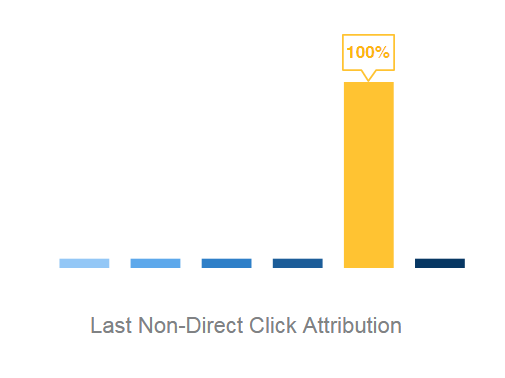
The Last Non-Direct Click Attribution model ignores all direct traffic and gives 100% credit of the conversion to the last channel the customer clicked through before converting. This can be any channel from email to social.
Last Non-Direct Click is a bit more useful than Last-Touch in that it has the potential to correctly give credit to the channel that drove the final conversion, while eliminating the need to deal with ‘Direct’ data which is often a catch-all for all traffic that isn’t properly filtered or tagged.
However, a big downfall of this model is that it completely undervalues Direct traffic, wherein a customer must remember your URL to visit your site and then convert, which in turn undervalues your branding efforts.
If a customer just received a well worded email campaign that prompted them to make a purchase, or they just got a promo code they’re now willing to use, why would any marketer want to give credit to the campaign they interacted with just before this one when it was this one that in fact prompted conversion? You wouldn’t, so most marketers have moved away from this model as well.
3. First Click Attribution Model
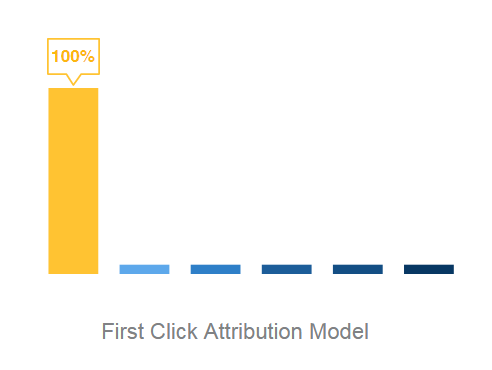 First Click or First Interaction attribution model assigns all credit to the first marketing event before conversion – it is the very opposite of the Last Click attribution model.
First Click or First Interaction attribution model assigns all credit to the first marketing event before conversion – it is the very opposite of the Last Click attribution model.
Again, its another attractive model because its so easy to use. And it does make sense, to an extent: you should definitely value the first customer interaction highly because without it, moving the customer along the decision making journey towards conversion is literally impossible.
But the First Click model doesn’t provide any actionable insight for marketers looking to optimize or measure their efforts. With Last Click attribution, at least we have some confidence in why and how that campaign triggered a conversion. First Click fails to show any data about the decision-making journey and gives too much credit to a single ad click.
4. Last Marketing Channel Touch Attribution
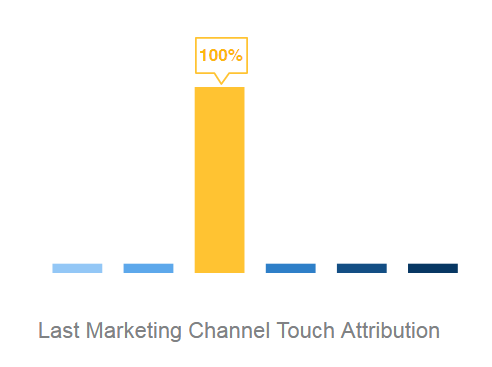
Last Marketing Channel Touch Attribution is channel specific. In other words, in this model, marketers would attribute the last known touch point specific to a channel to a conversion. For example, if you run Search you would use the Last AdWords Touch model. For Facebook, you would use the Last Facebook Touch and so forth.
But you can probably see the problem inherent with this model already: its incredibly biased towards its respective channels. You can easily overvalue the impact of each channel. If a visitor clicked a Search ad one day and then clicked a Facebook ad later in the week and then converted, each model will claim 100% credit for that conversion.
Rather than considering the model separately for each channel, aggregate them into a single report. This will give you a more holistic understanding of the multi-channel touchpoints that lead to a conversion.
The downside with this attribution model, however, is that you will see double or triple counted conversions which adds to your work load to further parse the conversion data.
5. Linear Attribution Model
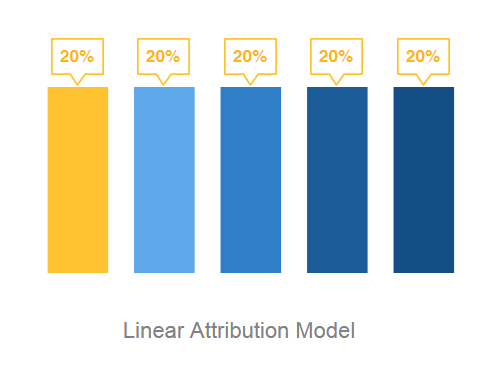
The Linear Attribution model gives each touchpoint along the conversion funnel, for example search, social, retargeting, direct, and email, equal credit for the final conversion.
This model is an improvement on all those we’ve discussed up to this point because it allows for credit to be applied to every single touchpoint along the buyer journey. It’s a simplified multi-touch attribution model.
That’s great! So what’s the problem now, you ask? Disproportionate weighting.
The Linear Attribution model fails to take into consideration the impact of all the other touch points which may have provided more value, and played a bigger role in triggering a conversion.
6. Time Decay Attribution
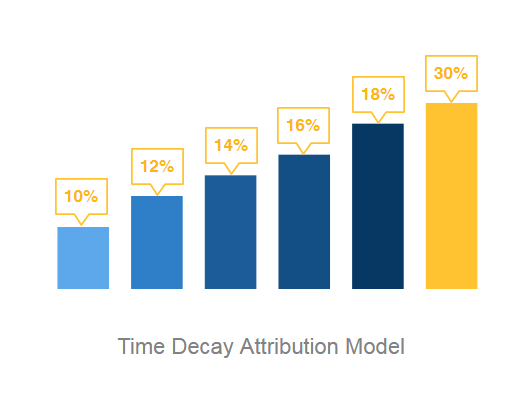
In the Time Decay attribution model, whichever touchpoint closest to the time when the sale or conversion took place receives the highest credit for the conversion. It functions under the assumption that the closer the interaction or click is to a conversion, the greater the impact that interaction had on the conversion.
The argument makes sense. And at least this is a multi-channel/multi-touch channel that also captures the data involved in the long decision making process.
One of its drawbacks, however, is that it may undervalue the heavy lifting that was done by marketing efforts higher up in the funnel which is always located farthest a way from the conversion point.
7. Position Based Attribution
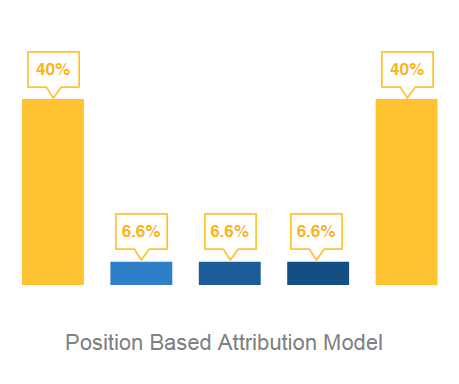
Typically, in the Position Based attribution model, the first interaction and the final interaction in the decision making journey before a conversion is given 40% credit for the conversion, respectively. The remaining 20% is distributed evenly between the other channels along the funnel, but such weighting can and should be adjusted.
The position Based model is a stronger attribution model that takes multiple touchpoints, and multiple channels into consideration. It credits two of the most important customer touchpoints: the first click or interaction (that which introduced the you to the customer) and the final interaction before conversion.
8. Algorithms Based (Custom) Attribution
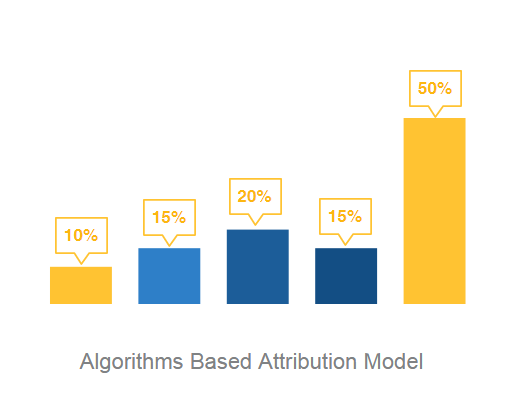
Algorithms or Custom built attribution models assigns credit for the conversion to each touchpoint based on its effectiveness.
This model requires advanced statistically modeling and continued optimization, based on your audience behaviour. It is in fact your existing customer data that will provide the foundations upon which to build your Algorithms attribution model, and understanding of which channel and which step in the decision making journey has the biggest impact on conversion.
The Algorithms attribution model is the most data-driven and provides the most comprehensive customer insight so marketers can identify non-traditional opportunities.
So what’s the final takeaway?
By today’s standards, we should all be steering clear of the First (only) or Last Interaction (only) attribution model. Choosing the right method for you will depend on your marketing needs and the required complexity of your marketing mix.
If it all seems too complicated, not to worry. Start with the simpler Time Decay and Position Based models, although again, avoid First and Last Click. To make attribution modeling of all your marketing campaigns accurate, all your campaigns must also be properly tagged and easily identified so you can give credit to where credit is due.
And finally, don’t just rely on conversion based attribution modeling. Consider other factors, including your CPA, not just conversions. How much does it cost you per acquisition per channel? Is the cost disproportionate to the value of the channel?
Taking all of your marketing efforts into consideration holistically will ultimately help you optimize for stronger campaigns, better targeting by channel and buying behaviour, and reduced spend for maximum performance.
Want to learn more? Connect with our team at sales@clearpier.com
The Ultimate ABCs of Programmatic Advertising: The B's and the C's
In this series, we set out to help you get fluent with the Programmatic language.
*This is part 2 of a series, The Ultimate ABCs of Programmatic Advertising. For part 1, click here.
We recently launched this series as an aid for every digital marketer out there who has ever been confused, annoyed, or even a bit frustrated with all the programmatic advertising jargon out there.
In this series, “The ABCs of Programmatic Advertising,” we set out to help you get fluent with all the specific terms and acronyms.
Today, we breakdown all the B’s and the C’s.
Banner
A web banner or banner ad is a type of advertising you’ll find online and can be delivered on desktop or on a mobile device. Banner ads are the billboards of the digital world and one of the earliest online ad formats as standardized by the IAB.
One of the earliest banner ads was this infamous AT&T ad which ran on HotWired.com back in October 1994 (Business Insider).

Bid
Like the lingo used in stock markets, a bid is the price advertisers are willing to pay for an ad impression. In real-time bidding (RTB), the buying and selling of online ad impressions in the real-time it takes a web page to load, an auction occurs for every impression. The advertiser’s bid is facilitated by a DSP (Demand Side Platform) or through an exchange. For the advertiser to win the auction with their bid, their bid must be higher than all others.
As technology has evolved and targeting parameters improved, the winning bid must also be a strong fit or match for the targeted audience visiting the website at any given time.
Bid Request
When a visitor loads a webpage, bid requests occur in the browser. This is when the ad server requests the ad exchanges which the publisher works with for an auction to take place to buy/sell a specific ad impression. The bid request is sent to buyers through the exchange and received on their DSP which in turn submits their bids in the auction for the impression. The winning bid is then served onto the web page to the visitor – all of this happens within a 100 milliseconds.
Brand Safety
One of the key goals for publishers and advertisers on both sides of the ad trading cycle: to ensure their brand integrity, or brand safety. Ad placements alongside objectionable or inappropriate content can be damaging to a brand, and this is a big concern.
As the digital advertising industry developed over the last five years, brand safety has become a priority.
Brand safety can therefore also refer to the practice of brand protection and use of ad verification tools to prevent objectionable content from being placed on a publishers’ site or vice versa. Some adtechs, like ClearPier, offer multi-level security measures that include technology and human verification.
Click-Through-Rate (CTR)
Click-through-rate (CTR) is the number of clicks that your ad receives divided by the number of times your ad is shown: clicks ÷ impressions = CTR. For example, if you had 5 clicks and 1000 impressions, then your CTR would be 0.5%.
Cost Per Action (CPA, A.K.A Pay Per Action or PPA)
CPA stands for ‘cost per action’. It is an online advertising pricing model wherein advertisers only pay when a completed action occurs, rather than for a set volume. Nearly anything can constitute an ‘action’ from impressions, to clicks, to leads (completed forms), views, or a sale. The desired action is dependent on the advertiser and the goal of each campaign. CPA is the basis of the pricing model for all Performance Advertising.
There are numerous variations of CPA that differ based on the final goal or action: CPA PC (cost per action post view), CPA PV (cost per action post view), CPL (cost per lead), CPC (cost per click), CPV (cost per view), CPI (cost per install).
Cookie

Not quite that type of cookie. In the digital world, a cookie is a small piece of data, or tracker that runs on web browser to track and identify a user’s online behavior and browsing habits.
Conversion
When someone, a potential customer, completes a pre-defined action and/or goal of a campaign such as a click, filling out a lead form, or completing a purchase.
Conversion Rate (CR)
A campaign’s conversion rate is the measure of ad clicks that ultimately result in conversions. To calculate conversion rate, you divide the number of conversions by the number clicks and multiply by 100. For example, you’ve made 100 t-shirt sales (conversions) after 1000 clicks: 100/1000 x 100 = 10% CR.
Cost Per Mille (CPM)
Cost Per Mille (CPM or cost-per-thousand) is another online advertising pricing model where buyers pay on the basis of every thousandth impression or view. CPM is not a new pricing model but was used in print advertising originally.
Cross-Device Tracking

Cross-device tracking is the many ways in which publishers, advertisers and ad tech identify and trace audience behaviour across numerous platforms and devices including desktop, tablets, and mobile phones. The goal? To provide a holistic view of the individual audience member’s behaviour online, regardless of the device they’re using, and enable proper, relevant ad retargeting.
Customer Lifetime Value (CLV)
Customer Lifetime Value (CLV), also known as Lifetime Customer Value (LCV), or life-time value (LTV), is the projected net profit a customer will generate during their time as a customer of your business. There are various ways to calculate your CLV, depending on your business model and goals. Check out this great infographic by Kissmetrics which looks at Starbucks as a case study on calculating CLV.
If you didn’t know, now you know.
Stay tuned for more in upcoming posts in this series. Next up, we explore and define the D’s – G’s of Programmatic.
Want to learn more? Connect with our team at sales@clearpier.com
[Infographic] What Exactly is Performance Marketing?
More brands are opting in to Performance Marketing.
When I first started in the digital advertising industry, one of the terms thrown around a lot – besides all of the other programmatic hullabaloo – was “Performance.”
My immediate thought was, well shouldn’t all advertising be performance based? Don’t you want to be able to accurately measure your campaigns?
We’ve created this infographic to clarify precisely what is Performance Marketing. Keep reading!
Want to achieve stronger performing campaigns? Connect with our team at sales@clearpier.com
Quiz: What Kind of Marketer Are You Actually?
A Social Media Maven, Brand Guru? Which one are you?
Want to learn more? Connect with our team at sales@clearpier.com











